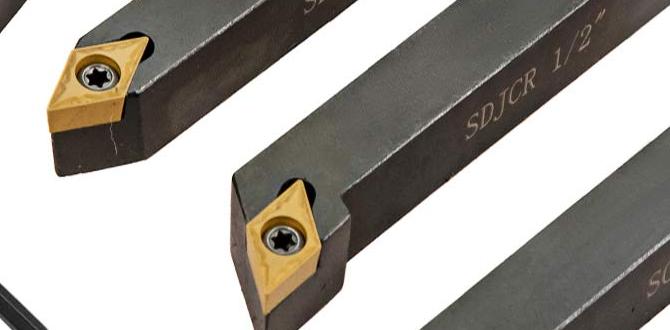Quick Summary: For a 1/2 inch carbide end mill in Inconel 718, start with spindle speeds around 300-500 RPM and feed rates of 0.001-0.002 inches per tooth (IPT). These are proven starting points to effectively machine this tough alloy while protecting your tooling.
Milling Inconel 718 can feel like a wrestling match, especially when you’re just starting out. This superalloy is known for its incredible strength and heat resistance, which makes it a dream for high-temperature applications but a real challenge for machinists. Getting your speeds and feeds wrong with a 1/2 inch carbide end mill can quickly lead to tool breakage, poor surface finish, or hours of frustrating work. But don’t worry, you’re not alone! With the right guidance, you can master these settings. We’ll walk you through proven speeds and feeds to make your Inconel milling projects successful and stress-free, helping you achieve great results every time.
Understanding Inconel 718 and Why Speeds & Feeds Matter
Inconel 718 is a nickel-based superalloy. This means it’s incredibly strong, tough, and can withstand very high temperatures. Think jet engines, rocket components, and oil and gas exploration. Its unique properties come from a special heat treatment process called precipitation hardening, which makes it extremely resistant to deformation and corrosion. While these qualities are fantastic for the end products, they make machining difficult. Inconel 718 has a tendency to work harden rapidly, meaning it gets tougher the more you cut it. This can quickly dull or chip your cutting tools if you’re not careful.
This is where precise speeds and feeds become crucial. They are the two fundamental settings that control how your end mill interacts with the material:
- Spindle Speed (RPM): This is how fast the cutting tool rotates. Too fast, and you can overheat and wear out your tool quickly. Too slow, and you might not be removing material efficiently or could induce chatter.
- Feed Rate (IPM or IPT): This is how fast the tool moves through the material. Measured in inches per minute (IPM) for the overall table movement or inches per tooth (IPT) for the material removed by each cutting edge. If the feed rate is too high, you risk breaking the tool or overloading the machine. Too low, and you’ll rub instead of cut, generating heat and poor surface finish.
Finding the sweet spot for speeds and feeds is like finding the perfect balance. For a 1/2 inch carbide end mill cutting Inconel 718, this balance is especially important because both the tool and the material demand respect. Carbide tools are brittle, and Inconel 718 is unforgiving. Get it right, and you’ll cut cleanly, extend tool life, and achieve excellent surface finishes. Get it wrong, and you’re looking at scrap parts and broken tools.
Choosing the Right 1/2 Inch Carbide End Mill for Inconel 718
Not all 1/2 inch carbide end mills are created equal, especially when tackling a beast like Inconel 718. For this tough material, you’ll want a tool specifically designed for high-temperature alloys. Here’s what to look for:
- Material: High-quality solid carbide is a must. Look for grades like WC (Tungsten Carbide) with a fine grain structure.
- Coatings: A good coating can significantly improve performance and tool life. For Inconel, coatings like TiAlN (Titanium Aluminum Nitride) or AlTiN (Aluminum Titanium Nitride) are excellent choices. They add a hard, heat-resistant layer that reduces friction and prevents welding onto the workpiece.
- Number of Flutes: This is critical. For Inconel 718, it’s generally recommended to use end mills with fewer flutes when roughing and slightly more for finishing. For a 1/2 inch diameter, a 2-flute or 3-flute end mill is often preferred for roughing to provide good chip evacuation and rigidity. For finishing, a 4-flute end mill might be used, but for general-purpose milling of Inconel, staying with 2 or 3 flutes is often the safest bet for beginners with a 1/2 inch tool. Fewer flutes mean more space for chips to clear, which is vital to prevent recutting and excessive heat.
- Geometry: Look for end mills with a high helix angle (around 30-45 degrees) and a slight radius or corner chamfer. The high helix helps with chip evacuation and reduces the cutting forces. The corner radius or chamfer adds strength to the cutting edge and helps prevent chipping. Some specialized end mills have a “form relief” or “form clearance,” which can also be beneficial for tougher materials.
Always check the manufacturer’s recommendations for the specific end mill you are using. They often provide detailed cutting data for various materials, which can be an invaluable starting point.
Proven 1/2 Inch Carbide End Mill Speeds & Feeds for Inconel 718
Machining Inconel 718 requires a cautious approach. The goal is to remove material efficiently without generating excessive heat or overloading the tool. Here are some proven starting points for a 1/2 inch, 2 or 3-flute carbide end mill. Remember, these are starting points; always adjust based on your machine’s rigidity, the coolant you’re using, and the chatter you hear.
Roughing Operations
Roughing is about removing bulk material quickly. For Inconel, this means taking moderate depths of cut and adjusting feeds and speeds to manage heat and chip load.
Key Considerations for Roughing:
- Depth of Cut (DOC): Start conservatively. For a 1/2 inch end mill, a radial depth of cut (how much the tool engages the material sideways) of 0.050″ to 0.100″ and an axial depth of cut (how deep it plunges or cuts into the material) of 0.100″ to 0.250″ is a reasonable starting point.
- Stepover: This is the distance the tool moves sideways between passes. For roughing, a stepover of 40-60% of the tool diameter (0.200″ to 0.300″ for a 1/2″ tool) is common.
- Coolant: A good flood of high-quality cutting fluid is essential. It cools the cutting zone, lubricates the cut, and flushes away chips. MQL (Minimum Quantity Lubrication) systems can also be effective if used properly with the right lubricants.
Recommended Roughing Speeds & Feeds:
For a 1/2 inch, 2 or 3-flute carbide end mill in Inconel 718 during roughing:
- Spindle Speed: 300 – 500 RPM
- Feed Per Tooth (IPT): 0.001 – 0.002 inches per tooth
- Feed Rate (IPM): Calculated as RPM x Flutes x IPT. For example, at 400 RPM, 3 flutes, and 0.0015 IPT: 400 RPM 3 Flutes 0.0015 IPT = 1.8 IPM.
Finishing Operations
Finishing is about achieving a precise size and a smooth surface. This requires lighter cuts and often different speeds and feeds to minimize heat and rubbing.
Key Considerations for Finishing:
- Depth of Cut (DOC): For finishing, you’ll take much shallower cuts. An axial DOC of 0.010″ to 0.020″ and a radial DOC of around 10-20% of the tool diameter (0.050″ to 0.100″) is typical.
- Stepover: To get a good surface finish, you’ll need a finer stepover. Think 20-30% of the tool diameter (0.100″ to 0.150″).
- Coolant: Maintain a strong coolant flow.
Recommended Finishing Speeds & Feeds:
For a 1/2 inch, 4-flute carbide end mill (or a 2/3 flute used for finishing with very light cuts) in Inconel 718 during finishing:
- Spindle Speed: 500 – 800 RPM
- Feed Per Tooth (IPT): 0.0005 – 0.001 inches per tooth
- Feed Rate (IPM): Calculated as RPM x Flutes x IPT. For example, at 600 RPM, 4 flutes, and 0.00075 IPT: 600 RPM 4 Flutes 0.00075 IPT = 1.8 IPM. Note: The IPM often ends up similar to roughing, but the depth of cut and stepover are drastically changed.
Table: Recommended Starting Speeds & Feeds for 1/2″ Carbide End Mill in Inconel 718
Here’s a quick reference table for your initial settings. Always listen to your machine and tool!
| Operation | End Mill Type (1/2″ Diameter) | Spindle Speed (RPM) | Feed Per Tooth (IPT) | Typical Radial DOC (per side) | Typical Axial DOC | Typical Stepover |
|---|---|---|---|---|---|---|
| Roughing | 2 or 3 Flute Carbide | 300 – 500 | 0.001 – 0.002 | 0.050″ – 0.100″ (20-40% diam.) | 0.100″ – 0.250″ | 0.200″ – 0.300″ (40-60% diam.) |
| Finishing | 4 Flute Carbide (or 2/3 Flute light cut) | 500 – 800 | 0.0005 – 0.001 | 0.025″ – 0.050″ (10-20% diam.) | 0.010″ – 0.020″ | 0.100″ – 0.150″ (20-30% diam.) |
Disclaimer: These are starting points only. Always verify with tool manufacturer data and your own successful test cuts.
Factors Influencing Your Speeds & Feeds
While the table above gives you a solid starting point, many variables can affect how well these numbers work in your shop. It’s important to understand these factors so you can make informed adjustments.
- Machine Rigidity: A sturdy, well-maintained milling machine will handle higher cutting forces than a lighter, less rigid one. If your machine tends to vibrate or chatter, you’ll need to reduce your feed rates and potentially your depths of cut.
- Coolant/Lubrication: Effective application of cutting fluid is crucial for Inconel. It cools the tool and workpiece, flushes chips, and lubricates the cutting interface. Using the right type of coolant and ensuring adequate flow can allow you to push speeds and feeds slightly higher than you could with dry machining. For Inconel, synthetic or semi-synthetic coolants with good lubricating properties are often recommended.
- Tool Stick-out: The length of the end mill that extends beyond the collet or holder affects its stiffness. Longer stick-out increases the chance of vibration and chatter. Try to keep your tool stick-out as short as possible for the geometry you are cutting.
- Work Holding: A securely held workpiece is paramount. If your part shifts or vibrates, it will impact the cut quality and can lead to tool breakage. Ensure your workpiece is clamped with sufficient force and that there’s no flex or movement.
- Chip Evacuation: Inconel chips can be stringy and tough. If chips aren’t cleared from the flutes and the cutting zone effectively, they can recut, increasing heat and tool wear. Using a high-pressure coolant system or an air blast can help.
- Inconel 718 Condition: Is the material annealed or in a hardened state? While machined for Inconel 718 often means starting with material that is already in a suitable condition for machining (often aged or solution-treated and aged), its exact condition can influence cutting forces.
Machining Strategies for Inconel 718
Beyond just speeds and feeds, your machining strategy plays a big role in success when milling Inconel.
High-Efficiency Machining (HEM) / Dynamic Milling
This is a modern machining strategy that uses a constant chip load and large radial engagement with a small axial depth of cut. It leverages newer tool path generation in CAM software and is excellent for hard materials like Inconel. These strategies aim to keep the tool in constant contact with the material, but with controlled engagement, reducing shock loads and heat buildup. This often means the tool is engaged at a high radial depth of cut (e.g., 50% of tool diameter) but a very shallow axial depth of cut (e.g., 0.010″ to 0.030″). While the exact parameters depend heavily on the CAM software and tool used, the principle is to maintain a consistent chip load across the entirety of the cut.
Conventional vs. Climb Milling
- Conventional Milling: The cutting tool rotates against the direction of feed. This tends to lift the workpiece and can lead to greater tool wear and a poorer surface finish, especially in gummy materials like Inconel. The chip thickness starts at zero and increases as the tooth engages.
- Climb Milling: The cutting tool rotates in the same direction as the feed. This pushes the workpiece down onto the table and generally results in a better surface finish, more efficient cutting, and longer tool life in Inconel. The chip thickness starts at its maximum and decreases to zero. This is generally the preferred method for Inconel.
Most modern CNC machines and CAM software will default to or easily allow for climb milling. Be aware that if your machine has significant backlash in its ways, climb milling can be problematic. However, for most CNC milling operations, climb milling is the way to go for Inconel.
Slotting and Pocketing
When creating slots or pockets, it’s crucial not to plunge the end mill straight down with an aggressive feed rate, as this can shock-load the tool. Use a helical interpolation (a spiraling motion) for plunging into the material whenever possible. This engages the tool gradually, similar to a conventional drill, but with the side cutting action of an end mill. For pocketing, employ a good trochoidal milling strategy where possible. This involves a series of small, curved movements that maintain a consistent chip load and prevent the tool from dwelling in one spot, which can cause heat buildup and work hardening.
For deeper cuts, consider taking multiple passes and clearing chips thoroughly between passes. Don’t be afraid to use a lower axial depth of cut and a reasonable stepover.
Coolants and Lubricants for Inconel Machining
Choosing the right coolant is critical for success with Inconel 718. It’s not just about cooling; it’s about lubrication and chip evacuation.
- Types of Coolants:
- Synthetics: High water content, excellent cooling, but can offer less lubricity. Often good for high-speed operations where heat is the primary concern.
- Semi-Synthetics: A good balance between cooling and lubrication. These are often very effective for Inconel.
- Soluble Oils: Offer good lubrication and cooling, but can leave residue.
For Inconel, a good quality semi-synthetic or soluble oil coolant with added extreme pressure (EP) additives is often recommended.
Minimum Quantity Lubrication (MQL): MQL systems deliver a very fine mist of lubricant directly to the cutting zone. When set up correctly, they can be highly effective for Inconel, providing lubrication and cooling precisely where needed while minimizing coolant mess. This requires specialized equipment and often specific MQL-formulated lubricants.
Key aspects of coolant use:
- High Pressure: Through-spindle coolant can be a game-changer for clearing chips from the flutes of the end mill, especially in deep cuts or small pockets.
- Flood Coolant: Ensure a strong flood of coolant is directed at the cutting zone from multiple angles.
- Chip Flushing: Regularly check that chips are being effectively flushed away.
<p






